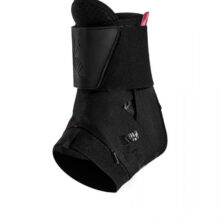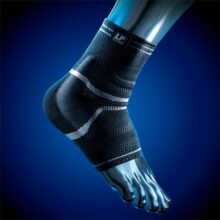Super Lite AFO
Typically Ships in 3-5 Business Days
The Super Lite AFO ankle brace counters the symptoms of drop foot by holding the foot in the correct position and helping the patient to avoid dragging the affected foot while walking
Ankle instability is a common condition characterized by a recurrent sensation of the ankle giving way or feeling unstable. It is usually caused by damage to the ankle ligaments as a result of trauma to the ankle. The commonest cause of this trauma is an ankle sprain. Inherent factors can, also, contribute to the the development of ankle instability.. This article aims to provide insights into the causes, symptoms, and treatment options for ankle instability.
The most common cause of ankle instability is a previous ankle sprain. Instability is likely to occur only if the sprain happens repeatedly. A single episode of ankle sprain is unlikely to lead to ankle instability. When the ligaments around the ankle joint are stretched or torn, they may not heal properly, leading to chronic instability.
Injuries that result in ligament damage, such as a severe sprain or ligament tears, can weaken the ligaments that stabilize the ankle joint. This weakened support can contribute to ankle instability.
Some individuals may have inherent factors that predispose them to ankle instability. Inherent factors are factors that people are born with that predispose them to ankle instability.These can include lax ligaments, structural abnormalities in the ankle joint or a family history of ankle instability.
The symptoms of ankle instability can vary in severity and may include:
Individuals with ankle instability are prone to recurrent ankle sprains, often triggered by minor movements or even while walking on uneven surfaces.
A constant sensation of the ankle being unstable or giving way, particularly during physical activities or weight-bearing tasks. Affected individuals often complain about a repeated ‘turning’ of the ankle, especially on uneven surfaces or when participating in sports. The ankle tends to feel wobbly or unstable.
Swelling around the ankle joint may persist, especially after periods of increased activity or following an ankle sprain.
Persistent pain or discomfort in the ankle joint, which can range from mild to severe, particularly after physical exertion or prolonged standing.
Muscular weakness and fatigue in the ankle and lower leg, making activities that require balance or sudden changes in direction challenging.
The treatment of ankle instability aims to alleviate symptoms, strengthen the ankle and improve stability. The approach may vary depending on the severity and underlying cause of the instability. Here are some common treatment options:
Rest, Ice, Compression, and Elevation (RICE) therapy is often the initial approach following an ankle sprain or during acute episodes of instability. It helps reduce pain, swelling, and inflammation.
A structured physical therapy program is essential to strengthen the muscles around the ankle joint, improve balance and range of motion as well as enhance proprioception. Therapeutic exercises, stretching, and balance training can significantly improve ankle stability.
The use of ankle braces or athletic taping techniques can provide external support to the ankle joint, enhancing stability during activities. These aids can help prevent excessive ankle movements that may lead to sprains.
Custom-made or over-the-counter orthotic devices, such as ankle-foot orthoses (AFOs) or shoe inserts, can provide additional support and stabilization to individuals with ankle instability.
Non-steroidal anti-inflammatory drugs (NSAIDs) like ibuprofen (advil, motrin) or naproxen (aleve) may be recommended to manage pain and reduce inflammation associated with ankle instability. Consultation with a healthcare professional is essential before starting any medication.
In cases of severe ligament damage or chronic instability that doesn’t respond to conservative treatments, surgical intervention may be considered. Fortunately, most cases of ankle instability will respond to conservative measures. Only a relatively small number of patients will need to have an operation.
Surgical options include ligament repair, reconstruction, or stabilization procedures. Sometimes, surgical correction can be achieved using a keyhole procedure. In the majority of cases, the surgery requires only an overnight stay in hospital.
Often, during the post-surgery convalescence, you will need to take a daily oral or injected blood-thinning medication to prevent a blood clot forming in your leg. Stabilisation of the leg in a plaster cast could be needed for about 6 to 12 weeks after the operation. Following removal of the plaster cast, you may need to wear an ankle brace or walker boot for up to 6 weeks. A period of physiotherapy is usually recommended at some point in the convalescence period. Many patients can resume light exercise about 3 months after the surgery. However, sporting activities involving twisting (such as football, rugby and squash) are not usually allowed until approximately 6 months have elapsed.
Engaging in activities that improve flexibility, strength, and balance, such as yoga or specific exercises, can help prevent future ankle injuries and promote overall ankle stability.
Ankle instability can significantly impact an individual’s quality of life, limiting activities and increasing the risk of further injuries.
Understanding the causes, recognizing the symptoms and seeking appropriate treatment are crucial in managing ankle instability effectively. Early intervention, physical therapy, and lifestyle modifications can significantly improve ankle stability, allowing individuals to return to their daily activities with confidence and reduced risk of future sprains.
Consulting with a healthcare professional is essential to determine the most suitable treatment plan based on individual needs and the severity of ankle instability.

Typically Ships in 3-5 Business Days
The Super Lite AFO ankle brace counters the symptoms of drop foot by holding the foot in the correct position and helping the patient to avoid dragging the affected foot while walking

In Stock
Mueller Sports Medicine TapeWrap is a breathable and cohesive bandage that offers an alternative to DynaPro SelfWrap or Andover PowerFlex.

In Stock
Mueller Sports Medicine Tear Light® Tape is a light adhesive tape featuring excellent conformability and easy tearing and unwinding.


In Stock
The Mueller Sports Medicine The ONE Ankle Brace is designed to be extremely light and low-profile. Offering all the traditional benefits of taping, but with all adjustable flexibility of a soft strap brace. Now replaced by the Mueller Sports Medicine The ONE Ankle Brace Premium.

In Stock
The Mueller Sports Medicine The One Ankle Brace Premium features a speed lacing system, figure 8 strapping pattern and a Comfort Band surrounding the plantar fascia and arch areas. Replaces the MU4664x ankle brace (The One Ankle Brace).

In Stock
The LP X-Tremus Ankle Support includes a Plantar Magic Power Band, Double-Eight Stable Contoured Structure, durable Fitting Knit and a J-shape silicone pad around the heel cord to offer a superlative combination of comfort, stability and injury protection.